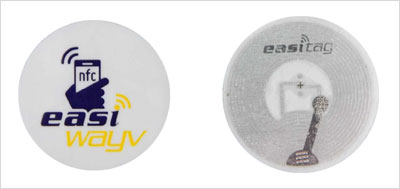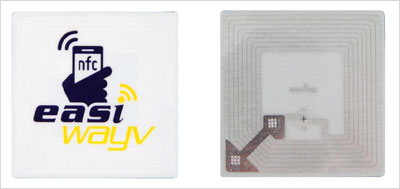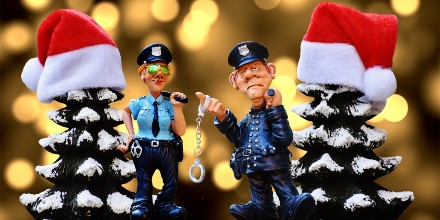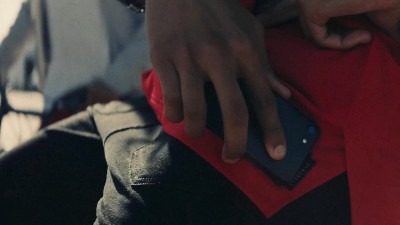Easitag produce NFC labels that have been designed, developed and manufactured for optimum performance.
Our writable NFC labels have a larger `hotspot` and are more user-friendly in a variety of indoor and outdoor applications.
Our goal in manufacturing these labels is to have adaptable labels that have the highest read capability whilst being the best priced in the market today.
Current NFC label requirements
Currently the major use for NFC reader/writer mode labels is to enable mobile devices to read data stored in passive NFC tags embedded in public posters, displays, and products, and to act upon that data that contains a (URL), or instruction for making a call, or the SMS instruction for sending a text message.
Our opinion is not to overcomplicate the NFC label requirement. Most uses of NFC labels will be for ‘redirecting mobile devices/readers’ therefore the chip capacity does not need to be too large or the label size too varied.
- In regards to chip or IC`s the NTAG 203 offers the best value, or bang for your buck on the market.
- 2 label sizes at 27 mm diameter & 37 mm square are the best available option and will cover the majority of application requirements.
Where to buy NFC tags in Australia
 NFC Label Sizes
NFC Label Sizes
Size Options
Coming Soon - NFC on Metal
NFC labels are available in a very wide selection of tag sizes (more specifically, antenna sizes) and shapes. Choosing which is right for you will usually come down to your particular application but here are some general guidelines.
 Optimum Antenna Size
Optimum Antenna Size
Put simply, for mobile phone use, we’d recommend a 27mm or 37mm tag (25mm or 35mm antenna) as the best option. The larger credit card sized antennas rarely perform better with mobile phones and they are usually a more expensive option. The reason for this is often that the larger tags require a greater amount of energy to create the current to power the chip; therefore the phone has to be held closer. Mobile phones relatively speaking don’t produce much ‘NFC power’ so the larger size doesn’t usually help.
Some frequent NFC Question & Answers:
Generally, we would advise that you select the right chip for your application first, then decide on the shape or format. Clearly, if you are purchasing wristbands or keyfobs your options are more limited, but for NFC stickers, you can use a design (printed, clear, white) and size.
-
What is the smallest NFC tag? What size is it?
The optimum size for an NFC tag is between 25mm and 38mm. The popular perception is that the larger the NFC tags the better the scan distance however this is not the case. If a tag is greater than 38mm the scan distance will not increase as a result and if the tag is smaller than 25mm the scan distance will reduce. -
Can I scan an NFC tag though objects such as a window or poster?
Yes. The scan distance of tags placed behind material such as wood, glass or plastic will be slightly less than air but the tags will still work. You can never place a tag behind metal. Special on-metal tags can be placed onto a metal surface but no NFC tag will work behind even a thin sheet of metal. -
What NFC tags should I use for a Smart Poster?
There are two primary aims for Smart Poster NFC tags. The first is to get maximum scan distance so that users can quickly and easily scan the tag. The second is to make sure that if the smart poster is going onto a metal surface; you use an on-metal or reverse on-metal tag. Maximising Scan Distance on Smart Posters For standard tags, we usually recommend the 37mm Easitag Quad. One trick which can help with usability is to use more than one tag on the back of the smart poster. Three tags arranged close together in a triangle creates a larger ‘hot spot’ and can help with the user experience. Using more tags doesn’t increase the scanning distance but creating a larger active area means the user can be less accurate and therefore can scan quicker and easier. Tags for Metal Surfaces If your smart poster is going to be placed onto a metal surface (or may be placed onto a metal surface) then you need to use an on-metal tag. A special ‘reverse’ on-metal tag which is specifically designed to be used with smart posters should be used. You simply stick the tag to the back of your poster and the on-metal part of the tag will be facing backwards with the tag facing forwards. If you have a gap of 5mm or more, you may get away with using a regular tag instead of an on-metal tag and you will probably find that the performance will be better. -
Can I print my own NFC tags with an inkjet printer?
In short, no, the issue revolves around two points. The first is that in large quantities normal etched NFC tags are always produced on reels not sheets so the conversion process to put them into sheets is tricky and expensive. The second issue is that with the NFC tag there is a bond between the NFC chip and the antenna. This bond is strong but doesn’t like being flexed or bent too much. Creating paper than can withstand the inkjet printing path is not easy. It has been done but it’s not a normal bond and as a specialist procedure it ends up being expensive. In the end, you get a very expensive sheet that means the tags cost a small fortune!
- 1
Want to know more about NFC? Talk to us today.
Still confused and want to know which NFC label or tag is best suited for your needs?
Freecall us today on 1800 077 375 to find out how we can help you.



